You’re rummaging through your grandmother’s china cabinet, and there it is, a stunning crystal glass that catches the light just so, creating a mesmerizing rainbow of reflections across your dining room.
But as you turn it over in your hands, you notice some peculiar markings at the base. What stories do these enigmatic crystal markings tell? What secrets about your family’s heritage might they unlock?
For countless collectors and inherited treasure keepers, these mysterious marks hold the key to understanding not just the value of their pieces but their authentic history and legacy.
As you embark on this journey of discovery, you’ll soon realize that these seemingly simple marks are anything but – they’re the crystalline fingerprints that can transform your curious findings into verified treasures.
- UNDERSTANDING THE LANGUAGE OF CRYSTAL MARKS
- WHAT IS CRYSTAL GLASSWARE MADE OF?
- HOW TO TELL IF IT’S REAL CRYSTAL?
- THE EVOLUTION OF CRYSTAL MARKING METHODS
- COMMON TYPES OF CRYSTAL MARKS
- READING AND INTERPRETING CRYSTAL MARKS
- CRYSTAL MARKINGS ON GLASSWARE
- CRYSTAL STEMWARE IDENTIFICATION GUIDELINES
- HOW TO IDENTIFY GLASS MARKINGS VS CRYSTAL MARKS
- DATING YOUR CRYSTAL THROUGH MARKS
- HOW TO IDENTIFY VINTAGE ETCHED GLASSWARE?
- HOW TO TELL IF GLASSWARE IS VINTAGE OR ANTIQUE
- CARE AND PRESERVATION OF MARKED CRYSTAL
- THE VALUE OF PROPER IDENTIFICATION
- EXPERT TIPS FOR COLLECTORS
- COMMON MISTAKES TO AVOID
- IS CRYSTAL GLASSWARE WORTH ANYTHING?
- THE EASIEST WAY TO IDENTIFY CRYSTAL
- CONCLUSION
UNDERSTANDING THE LANGUAGE OF CRYSTAL MARKS
Crystal markings are rather like the DNA of fine glassware – they tell us everything from the piece’s origin to its age and authenticity.
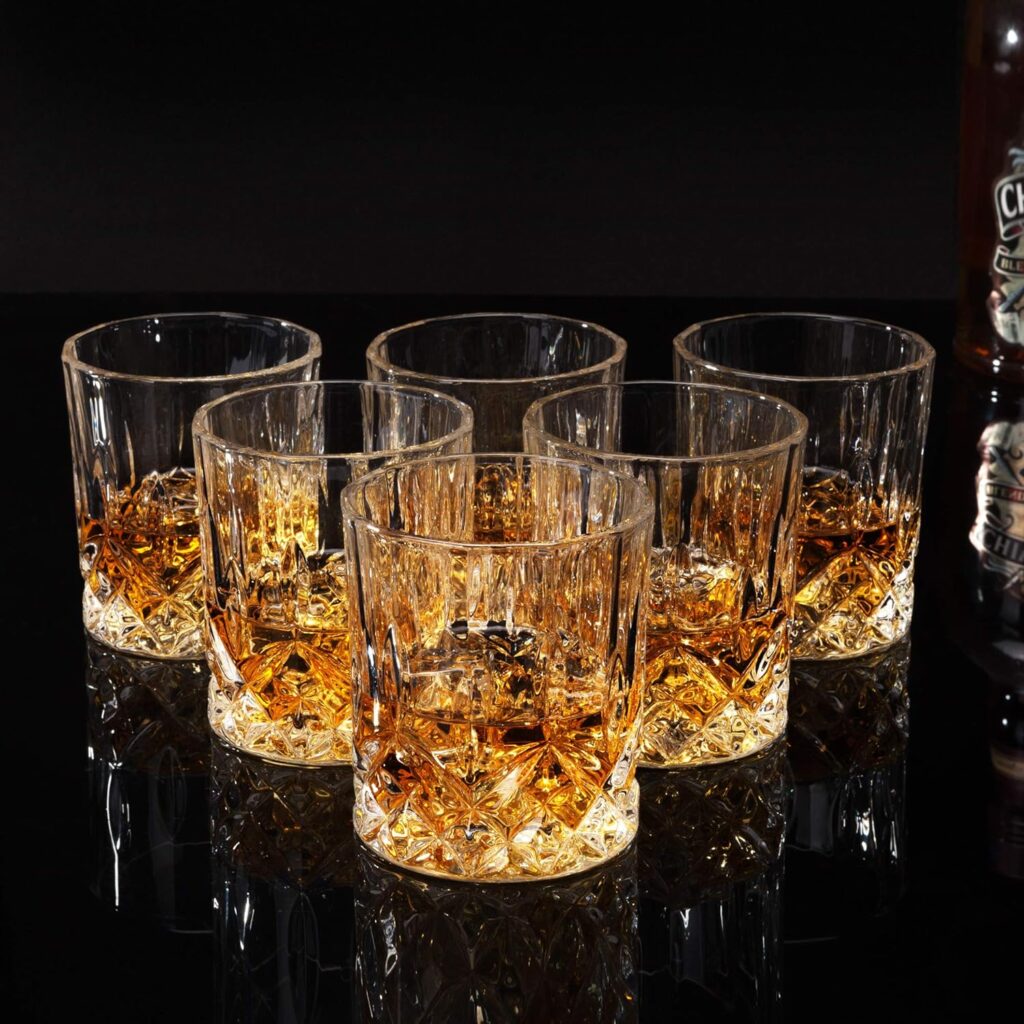
Just as Waterford crystal markings have their distinctive characteristics, each manufacturer developed their own unique “signature” over time.
These marks aren’t just random scratches or logos; they’re carefully crafted identifiers that speak volumes to those who know how to read them.
WHAT IS CRYSTAL GLASSWARE MADE OF?
Before diving into identification, it’s essential to understand what sets crystal apart from ordinary glass.
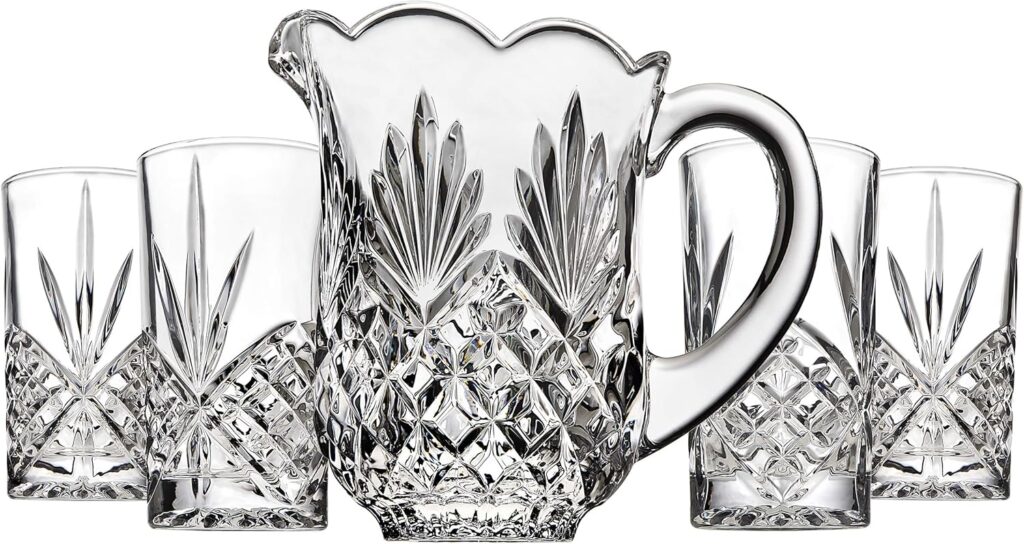
Crystal glassware contains a minimum of 24% lead oxide (PbO), which gives it its distinctive properties:
– Enhanced clarity and brilliance
– Greater light refraction
– Increased durability
– Superior resonance when “clinked”
– Higher weight than regular glass
Modern lead-free crystal alternatives use minerals like zinc oxide or potassium oxide to achieve similar characteristics while being more environmentally friendly.
HOW TO TELL IF IT’S REAL CRYSTAL?
There are several foolproof methods to distinguish genuine crystal from regular glass:
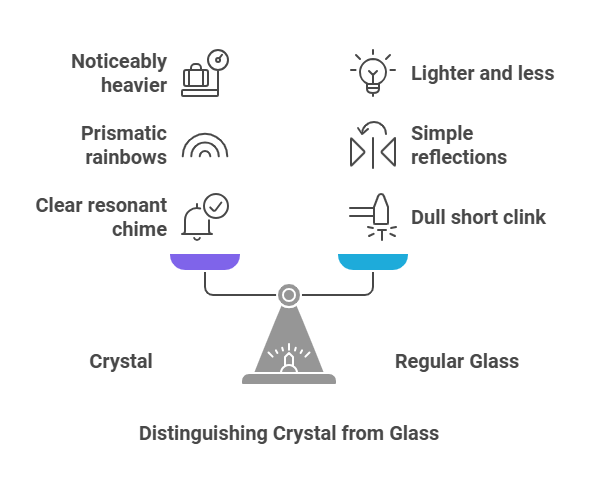
The Ring Test
Hold the glass by the stem and gently flick it with your finger:
– Crystal produces a clear, resonant chime
– Regular glass makes a dull, short-lived ‘clink’
The Light Test
Hold the piece up to a light source:
– Crystal creates prismatic rainbows
– Regular glass produces simple reflections
The Weight Test
Compare similar pieces:
– Crystal feels noticeably heavier
– Regular glass feels lighter and less substantial
THE EVOLUTION OF CRYSTAL MARKING METHODS
Throughout history, manufacturers have employed various techniques to mark their crystal pieces:
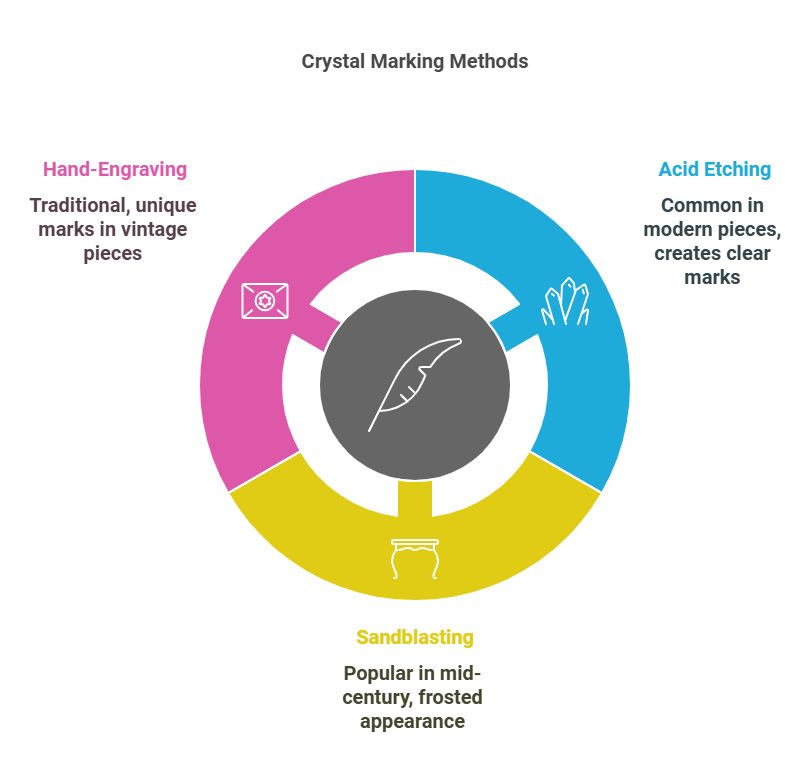
1. Acid Etching
– Most common in modern pieces
– Creates clear, precise marks
– Usually found on the bottom of the piece
2. Sandblasting
– Popular in mid-century pieces
– Creates a frosted appearance
– Often used for larger marks
3. Hand-Engraving
– Traditional method
– Each mark slightly unique
– Found in vintage and antique pieces
COMMON TYPES OF CRYSTAL MARKS
Understanding different types of marks is crucial for proper identification. While some collectors might be familiar with identifying Mikasa crystal marks, each manufacturer has its distinctive style.
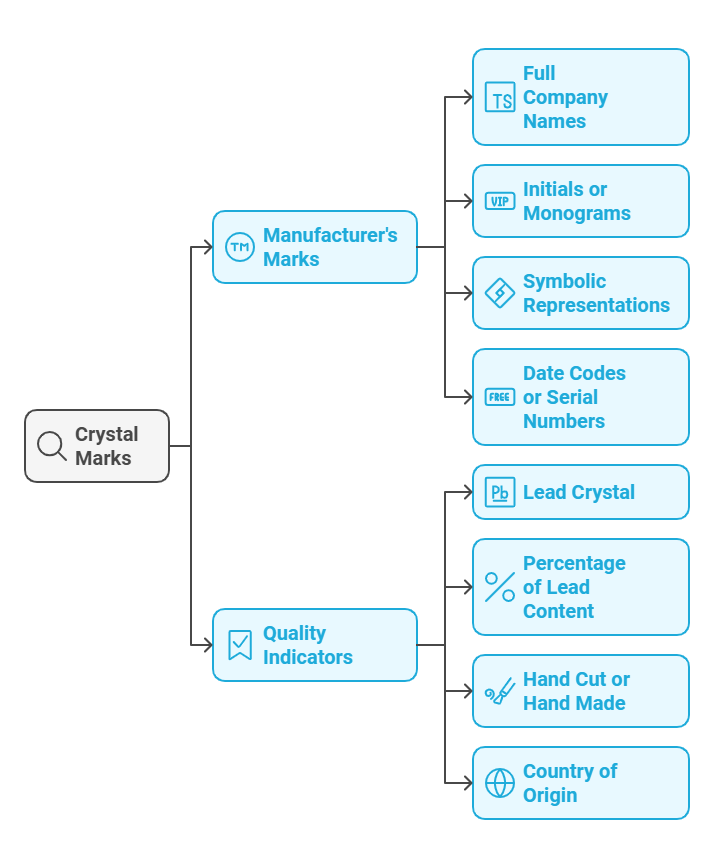
Manufacturer’s Marks
The most common type of crystal marking is the manufacturer’s signature or logo. These can appear as:
– Full company names
– Initials or monograms
– Symbolic representations
– Date codes or serial numbers
Quality Indicators
Quality marks often appear alongside the manufacturer’s marks and can include:
– “Lead Crystal” or “Full Lead Crystal”
– Percentage of lead content (24% PbO)
– “Hand Cut” or “Hand Made”
– Country of origin
READING AND INTERPRETING CRYSTAL MARKS
Much like Fiestaware with markings, crystal pieces tell their stories through various symbols and codes.
Here’s how to decode them:
Step-by-Step Authentication Process
1. Clean the piece carefully
– Use a soft, lint-free cloth
– Avoid harsh chemicals
– Ensure proper lighting
2. Locate the marking
– Check the base
– Look for marks on the stem
– Examine the rim
3. Document what you find
– Photograph the marks
– Note their location
– Measure their size
Table: Common Manufacturer Marks and Their Meanings
| Manufacturer | Common Marks | Years Used | Notable Features |
| Waterford | Acid-etched seahorse | 1950-present | Bold, clear etching |
| Mikasa | “M” in crystal | 1970-present | Often includes a year code |
| Lalique | “R. LALIQUE” | 1925-1945 | Cursive script |
| Baccarat | Registered trademark symbol | 1936-present | Often includes year code |
CRYSTAL MARKINGS ON GLASSWARE
Below are the various ways manufacturers employ to mark their glass products.
Techniques and common locations include:
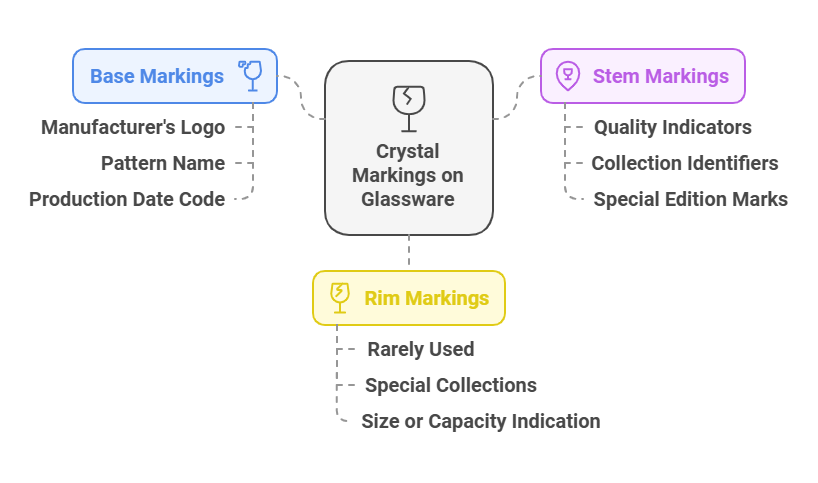
1. Base Markings
– Manufacturer’s logo
– Pattern name
– Production date code
2. Stem Markings
– Quality indicators
– Collection identifiers
– Special edition marks
3. Rim Markings
– Rarely used
– Usually denotes special collections
– Sometimes indicates size or capacity
CRYSTAL STEMWARE IDENTIFICATION GUIDELINES
Just as collectors learn about various ways of identifying various glassware brands, here are the specific guidelines that exist for stemware identification:
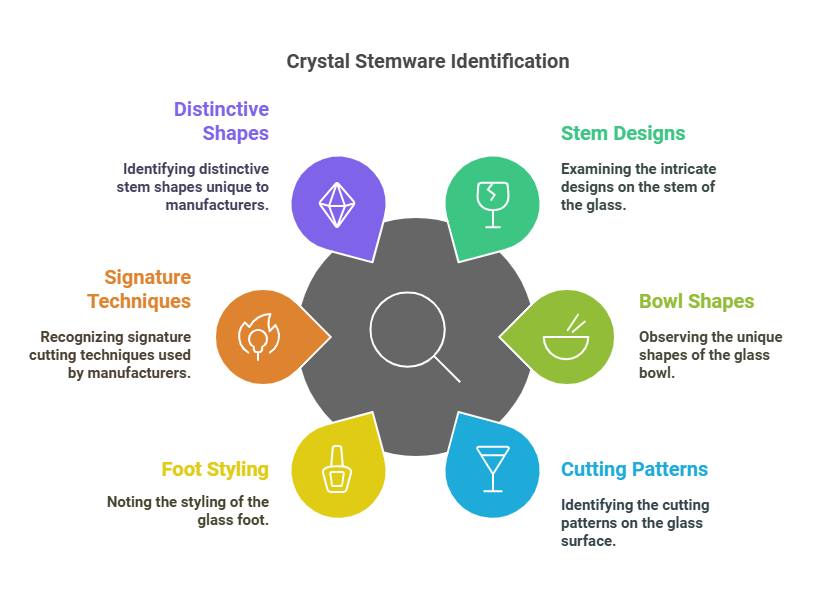
Pattern Recognition
– Study stem designs
– Note bowl shapes
– Examine cutting patterns
– Compare foot styling
Manufacturer-Specific Features
– Signature cutting techniques
– Distinctive stem shapes
– Unique marking placements
HOW TO IDENTIFY GLASS MARKINGS VS CRYSTAL MARKS
Glass and crystal markings differ in several key ways:

Glass Markings Characteristics
– Often molded into the piece
– Less detailed
– Usually simpler logos
– Factory codes are common
Crystal Marks Characteristics
– Usually acid-etched or hand-engraved
– More intricate details
– Complex maker’s marks
– Quality indicators present
DATING YOUR CRYSTAL THROUGH MARKS
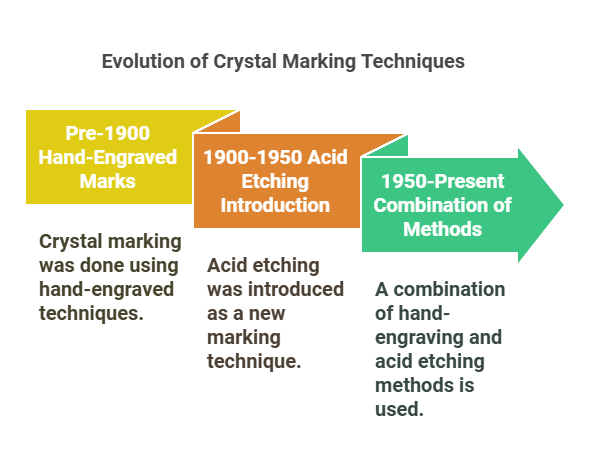
Understanding the age of your crystal involves more than just reading the marks.
Consider these factors:
Period-Specific Characteristics
– Pre-1900: Often hand-engraved marks
– 1900-1950: Introduction of acid etching
– 1950-present: Combination of methods
HOW TO IDENTIFY VINTAGE ETCHED GLASSWARE?
1. Examine the Etching
– Hand-etched pieces show slight irregularities
– Machine-etched patterns are perfectly uniform
– Period-specific motifs help date pieces
2. Study the Pattern
– Record pattern names
– Research production dates
– Note any pattern variations
HOW TO TELL IF GLASSWARE IS VINTAGE OR ANTIQUE
1. Age Indicators
– Wear patterns on the base
– Style of cutting
– Type of glass composition
2. Manufacturing Techniques
– Hand-finishing marks
– Pontil marks
– Mould lines
CARE AND PRESERVATION OF MARKED CRYSTAL
To maintain the legibility of crystal marks:
1. Proper Cleaning
– Use lukewarm water
– Avoid abrasive materials
– Pat dry immediately
2. Storage Recommendations
– Store pieces separately
– Avoid stacking
– Keep away from direct sunlight
THE VALUE OF PROPER IDENTIFICATION
Knowing your crystal marks can:
– Determine authenticity
– Establish value
– Guide proper care
– Connect to history
EXPERT TIPS FOR COLLECTORS
1. Build a Reference Library
– Collect manufacturer catalogs
– Join collector groups
– Document your findings
2. Use Technology
– Magnifying tools
– UV lights for authentication
– Digital archives
COMMON MISTAKES TO AVOID
1. Misidentification Pitfalls
– Confusing similar marks
– Overlooking wear patterns
– Assuming age based on style
2. Authentication Errors
– Rushing the process
– Poor lighting conditions
– Incomplete research
IS CRYSTAL GLASSWARE WORTH ANYTHING?
The value of crystal glassware depends on several factors:
Value Determinants
1. Manufacturer Prestige
– High-end makers command premium prices
– Limited editions increase value
– Historical significance matters
2. Condition
– Mint condition pieces fetch the highest prices
– Original packaging adds value
– Documentation increases worth
3. Rarity
– Discontinued patterns are valuable
– Limited production runs
– Special commemorative pieces
THE EASIEST WAY TO IDENTIFY CRYSTAL
1. Quick Physical Tests
– Lead pencil test (real crystal feels smooth)
– Sound test (crystal resonates)
– Light refraction test
2. Visual Examination
– Look for maker’s marks
– Check cutting quality
– Assess weight
CONCLUSION
The world of crystal markings is a fascinating journey through craftsmanship and history.
Whether you’re a serious collector or simply curious about family heirlooms, understanding these marks opens up a world of appreciation for these beautiful pieces.
Remember, each mark tells a story – it’s up to us to learn how to read it.
Further Reading: